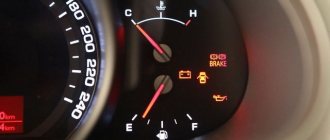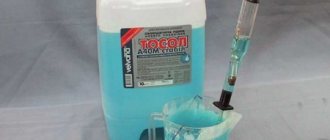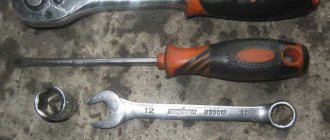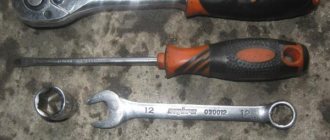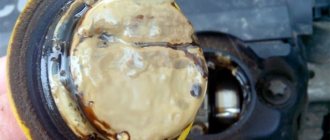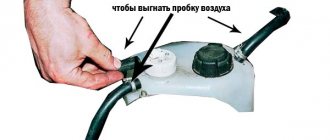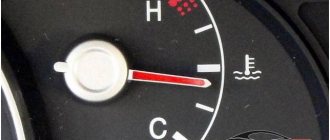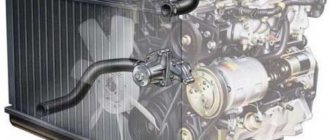The use of antifreeze by drivers in winter is an irreplaceable circumstance, because it ensures stable and safe engine operation. But one of the main problems for the driver is the boiling of the liquid, so it is important to know what the boiling point of the antifreeze is. Knowing this will help prevent unwanted poisoning from chemicals (which quickly affect the bodies of children and animals), and keep the car in good condition.
The main element in all coolants used by motorists is ethylene glycol diluted with water. This mixture is toxic and negatively affects the nervous system.
, if it enters the body, especially through the respiratory tract. Antifreeze is classified as such a liquid. Its freezing point varies from -40 to -65 C, and its boiling point is within 100 C.
Causes of coolant boiling
All the reasons why antifreeze boils are more or less related to the breakdown of car parts.
All malfunctions lead to expansion of antifreeze in the tank, which in turn causes engine overheating. Regardless of the color of the antifreeze used (blue or red), the boiling point is at around 100C. Although some manufacturers, using special additives and elements, increased this temperature to 108C. The reasons for boiling, as well as temperature, are the same for antifreeze and antifreeze.
And, although different manufacturers indicate different numbers on different packages, it remains obvious that any liquid begins to turn into a gaseous state when the temperature exceeds 100C. If the climate indicator is always constant, then another condition for boiling antifreeze manifests itself in the malfunction of various parts, for example:
- Thermostat
- Radiator cooling mechanism
- Pumps
- Fan
- Temperature sensor
- Presence of an air lock in the cooling system
- Too low antifreeze in the system
Causes of boiling and their solutions
To begin with, we will analyze in detail all the reasons why antifreeze boils.
- Faulty thermostat .
The main task of this device is not to supply coolant to the radiator until the engine reaches a certain operating temperature (usually +85°C), that is, to transfer it to the so-called “large circle”. However, if the unit does not turn on in time and does not circulate the coolant through the system, it will quickly heat up in the “small circle” along with the engine and simply boil because it will not have time to cool. Dirty thermostat - Faulty radiator . The function of this unit is to cool the antifreeze and maintain the cooling system in working order. However, it may suffer mechanical damage or simply become clogged from the inside or outside.
- (centrifugal pump) failure Since the task of this mechanism is to pump coolant, if it fails, its circulation stops, and the volume of liquid that is in close proximity to the engine begins to heat up very much and, as a result, boils.
- Low antifreeze level . A cooling system that is not filled to the required level does not cope with its task, so the temperature exceeds the critical temperature and the liquid boils.
- Cooling fan failure . Its function is to force cool the elements of the system of the same name and the liquid. It is clear that if the fan does not turn on, the temperature will not drop and this may result in the antifreeze liquid boiling. This situation is especially critical for the warm season.
- Presence of an air lock . The main reason for its appearance is depressurization of the cooling system. As a result, several factors harmful to it arise at once. In particular, the pressure drops, which means the boiling point of antifreeze decreases. Further, when air remains in the system for a long time, the inhibitors included in the antifreeze deteriorate and do not perform their protective function. And finally, the coolant level drops. This has already been mentioned earlier.
- Temperature sensor failure .
Everything is simple here. This unit has not sent the appropriate commands to the thermostat and/or fan. They did not turn on and the cooling system and radiator boiled. Pump corroded by antifreeze - Poor quality antifreeze . If the car is filled with low-quality antifreeze, that is, a liquid that does not meet the necessary requirements, which means there is a high probability that the radiator will boil. In particular, we are talking about the fact that counterfeit coolant often boils at temperatures below +100°C.
- Antifreeze foaming . This can happen for various reasons. For example, low quality coolant, mixing incompatible antifreeze, using antifreeze that is not suitable for the car, damage to the cylinder block gasket, which causes air to enter the cooling system, and as a result, its chemical reaction with the coolant to form foam.
- Depressurization of the tank lid . The problem may be either a failure of the safety bleed valve or a depressurization of the cover gasket. Moreover, this applies to both the expansion tank cap and the radiator cap. Because of this, the pressure in the cooling system is compared to atmospheric pressure, and therefore the boiling point of the antifreeze decreases.
To restore the functionality of the cooling system, and in future to prevent situations where antifreeze or antifreeze boils quickly, it is necessary to inspect the components listed above. Let us list the sequence in which it is necessary to check the specified components in accordance with the probability and frequency with which they fail.
Antifreeze foaming
- Expansion tank and its cap . This is especially true if the antifreeze in the expansion tank has boiled and steam is coming from underneath it. It is better to replace the entire cap and valve.
- Thermostat . This unit needs to be checked if the radiator is cold and the antifreeze is boiling when the engine is turned on. It also makes sense to check the thermostat after replacing the coolant if it immediately boils.
- Cooling Fan . It rarely fails, but it makes sense to check. As a rule, problems arise in dropped contacts or breakdown of the insulation of the stator and/or rotor windings.
- Temperature sensor . The device is quite reliable, but sometimes fails on older machines. Actually, it controls the operation of the fan on the radiator
- Centrifugal pump (pump) . This is similar to the previous point..
- Cooling radiator . It is necessary to carefully inspect it for damage and possible coolant leaks. If it leaks (this will be accompanied by a situation where antifreeze is leaking), then it is necessary to dismantle it and solder it. As a last resort, replace it with a new one. You can simply clean it if it is very clogged. For external cleaning it is better to remove it. And internal cleaning occurs along with the entire cooling system (without dismantling).
- Check the antifreeze level in the system . It can leak from a damaged system, and the remaining volume cannot withstand the heat load and boils. If a low-quality liquid with a low boiling point is used, it must be replaced completely. Otherwise, you can simply add antifreeze.
- Check whether the added antifreeze is suitable for the current car . If there was a mixing of two brands of coolant, make sure that they are compatible with each other.
- Check the operation of the safety release valve . You can check the operation of the valve on the lid using polyethylene.
- Check the quality of the filled antifreeze . This can be done in several ways, using both professional equipment and improvised means available in the garage or at home.
Bad antifreeze is death to the engine
The boiling and freezing points of coolant depend on the composition. The consequence of pouring bad (fake) antifreeze is boiling and destruction of the engine. Find out the signs and testing methods to determine that it is bad Read more
As a rule, you only need to complete one of the listed points. However, in difficult situations, failure of several of the listed units is possible.
Remember that all repair and maintenance work on the cooling system must be performed only when the engine is cool. Under no circumstances should you open the expansion tank cap when the engine is hot! This way you risk getting a severe burn!
Often, boiling occurs when the car is moving in a lower gear while the engine is running at high speeds, for example, during long driving in the mountains or in city traffic jams in the summer heat. The situation is aggravated if the air conditioning is turned on, since it puts additional load on the cooling system, in particular the main radiator. Therefore, before traveling to the mountains, be sure to check the condition of the engine cooling system, including the level of antifreeze in it. If necessary, top it up or replace it.
It is not recommended to use antifreeze that contains more than 60% ethylene glycol by volume and less than 40% water by volume.
Often the cause of antifreeze boiling can be the formation of an air lock in the cooling system. Symptoms of its formation are problems with the thermostat, antifreeze leakage, problems with the pump and the interior heater. Therefore, if at least one of the listed problems exists on your car, then it is recommended to correct the situation, since ignoring it can cause the engine to boil.
Some drivers are interested in the question of why antifreeze boils after stopping? There are several options here. The first is when the car is stationary with the engine running. This means that this is just a coincidence, and you are lucky that you discovered a situation when antifreeze boiled not while driving, but on the road or in the garage. In this case, immediately turn off the engine and set the car to the handbrake. We'll talk about further actions a little later.
Low antifreeze level
Another possibility is that smoke (steam) continues to come from under the hood after you have detected a boil and pulled over to the side of the road. It is necessary to understand that most liquids, and antifreeze is no exception, have a high thermal specificity. This means that it takes a long time to heat up and cool down. Therefore, the situation is when you observe boiling coolant, which will stop evaporating some time after stopping the engine.
There are exotic options when it bubbles in the expansion tank after the engine is turned off. For example, the situation described below is relevant for the Chrysler Stratus. It consists in the fact that after stopping the engine, the radiator safety valve releases pressure into the expansion tank. And the effect is that everything is boiling there. Many car enthusiasts mistake this process as a blown cylinder head gasket and rush to change it. However, there is no need to rush, but instead it makes sense to carefully study the cooling system diagram of a particular car.
Average superheat
If the boiling point has not been reduced within 20 minutes, then such overheating should be classified as a moderate case. At the same time, the consequences become more significant and lead to the breakdown of other parts, for example:
- Curvature of cylinder heads
- Cracks in cylinder heads
- Burning or melting of the cylinder block
- Engine oil leaking through seals
At this level of overheating, the main cause is poor or incomplete technical inspection. An inexperienced specialist or an irresponsible inspection of the vehicle may miss a significant breakdown.
Problems when boiling
The first action of a motorist when antifreeze boils is to stop the car, identify the cause of the breakdown and eliminate it. Further operation of the vehicle depends on whether the malfunction is eliminated or not. The consequences of boiling antifreeze with further use of the machine leads to the following:
- the cooling system pipes become unusable;
- there is a leak in the radiator;
- the wear resistance of the piston rings decreases;
- grease will come out from under the lip seals.
Ignoring problems with the cooling system for a long time will cause destruction of the valve seats, partitions between the piston rings, damage to the cylinder heads and gaskets in them.
The risk of an emergency situation associated with boiling antifreeze will be reduced if you carefully monitor the operation of the cooling system. You should select high-quality coolant that meets the operating requirements of a specific car brand.
Severe overheating
Very often, at this level, a car can suffer irreparable damage and not only the vehicle can be destroyed, but also endanger the health or life of passengers. Such consequences can occur after an engine explosion inside. Mostly new cars have a fairly well-thought-out engine system and it takes different periods of time for various parts to deteriorate, so the engine simply stalls.
In addition, the parts that surround it experience a destructive impact. If the antifreeze continues to boil for more than 25 minutes, the pistons begin to melt, due to problems with the engine fluid, all rubbing parts break, and the crankshaft breaks.
Useful tips
In the case of diluting antifreeze or in the case of diluting antifreeze, you should not use the first water you come across.
The water hardness for dilution should reach about 5 units.
It is also undesirable to obtain such an effect that the antifreeze reaches the boiling point during its operation in the car, since it will begin to release various gases during the chemical reaction and will lose its main advantages, namely, during operation it will not be able to cool the engine in the car with maximum efficiency .
It is also important to take into account that if the efficiency of removing engine heat into cooling. the vehicle system will be reduced, in which case excessive overheating of the engine begins.
Solving the situation
If the boiling process has already begun, then measures must be taken as quickly as possible to cool the engine, and therefore the antifreeze in it. The first thing to do is remove any load from the engine. It cannot be stopped abruptly, but only brought to a stop as smoothly as possible. It is advisable to immediately turn on the fan to reduce the temperature at least a little. The engine can only be turned off after the vehicle has come to a complete stop.
. After this, the driver should get out of the car and open the hood.
In this case, it is strictly forbidden to open the expansion tank, since antifreeze, under the influence of pressure, can splash on a person. Only after 30 minutes can you call a tow truck and take the car to the nearest inspection station. If possible, the car can also be towed.
What is modern car antifreeze?
Antifreeze is a non-freezing mixture. Antifreeze is also often used in heating systems.
You can find many types of antifreeze on the market, the main components of which are solutions based on a mixture based on chemical additives: you can also purchase full-fledged compositions based on polyhydric alcohols for your car.
- To obtain high-quality antifreeze, it is necessary (almost always) to add additives that make the above mixture more reliable for the heating system itself.
- A secondary useful characteristic of the refrigerant is its low freezing point and high boiling point (this will be discussed in the article).
- The latest antifreezes include various types of additives for high-quality cooling of a car engine.
In general, this refrigerant is made on the basis of several types of atomic alcohols, including antifreeze made on the basis of ethylene glycol or propylene glycol. Most often based on ethylene glycol, especially for modern mixtures for cars. One of the main qualities of antifreeze is its high boiling temperature.
It is also important to consider that another task of the engine coolant, after the car engine has been cooled to a comfortable temperature, is high-quality heating in the cabin.
Summing up
Consequently, the boiling temperature of antifreeze not only deteriorates the engine. Enormous damage can be caused to the entire car, as well as to human health and life. The driver needs to avoid the 100C mark
on the engine temperature sensor, and also undergo technical inspection in a timely and responsible manner. The antifreeze must be of high quality and from the original manufacturer, because when buying a cheap and low-quality liquid, there is a risk to the life of the one who purchases it. Take care of yourself and your passengers in advance.
← Previous material
Next material →
At what viscosity does antifreeze boil?
Graph of the general dependence of the viscosity index on the temperature value
The picture is surprising, because liquids, even if they are of the same type and have the same shade, should never be mixed with each other.
In fact, the refrigerant is almost always made in the same shade, in other words, antifreeze usually does not have any color, but already at the last stage of manufacturing the company - manufacturers add a simple dye of a certain shade to it in order to give the mixture some color. then a special or individual shade.
By the way, you don’t have to think about this topic, since no dye almost ever reduces the performance of the engine and does not affect the properties of antifreeze.
There are also often rumors that companies also pour certain lubricating additives into the antifreeze; these are essentially just rumors that have nothing in common with reality.
As for the average freezing point of the mixture, the boiling point of antifreeze is about – 110 degrees, and the boiling point of antifreeze is about – 120 °C. At the same time, the differences do not seem to be particularly noticeable, but during the heat of the street this plays a certain role.
Video “What to do if the engine boils?”
The INFLATED WHEELS channel has provided a video that will help you understand what should be done first when a car power unit overheats.
Do you have any questions? Specialists and readers of the AUTODVIG website will help you ask a question
Was this article helpful?
Thank you for your opinion!
The article was useful. Please share the information with your friends.
Yes (83.33%)
No (16.67%)
X
Please write what is wrong and leave recommendations on the article
Cancel reply
Rate this article: ( 6 votes, average: 4.83 out of 5)
Discuss the article:
What not to do
There are several simple rules that should be followed when the coolant boils. By following them, you will protect yourself from possible injuries (burns), and the engine from the need for major repairs:
- reduce the speed to a minimum, do not accelerate so that the engine does not experience stress;
- after stopping, do not turn off the engine immediately, let it run for at least a minute or two;
- Having opened the hood, do not touch the parts and assemblies, as they are very hot;
- do not water the power unit with cold water - a sharp temperature change will not lead to anything good, and it can also cause a short circuit in electrical equipment; it is necessary to wait for the engine to cool down on its own, gradually, with natural air flowing around it;
- After the engine has cooled down and coolant has been added, you cannot continue driving when the temperature reaches more than 90 degrees.
Compliance with these requirements will protect the driver and reduce the material costs of restoring normal engine performance.
If you have any questions, leave them in the comments below the article. We or our visitors will be happy to answer them
How the cooling system works
The classic cooling unit of a modern car works on the principle of liquid circulation. While the engine is cooled, the coolant circulates in a small circle, affecting the water jacket, heater and temperature-sensitive element. The antifreeze level is normal.
After heating the power unit, a large circle opens. The rotation of the liquid already affects the main radiator. The refrigerant expands and excess flows into the tank. The pressure is reduced due to the operation of the lid overflow valve. At 100°©, the volume of liquid increases to a maximum, its excess is discharged - it is at this moment that the antifreeze boils. As the engine cools, the coolant contracts, pressure and boiling decrease. This is a normal process during which antifreeze naturally heats up and cools down.
There are several types of internal combustion engine cooling systems.
- Air. It is a blowing with cold currents that displaces hot air from the engine space to the outside. Such a system can be natural or forced with a fan. The efficiency of this type, especially for modern engines, is very low. Therefore, it is used only in combination with liquid.
- Liquid. The system is formed by tubular circuits through which the refrigerant circulates. It can be forced-type with a pump or thermosyphon. In the latter case, circulation is carried out due to the difference in densities of the heated and cold liquid. Typically, these two types are combined together, which gives greater efficiency.
- Combined. Air blowing and a fluid circuit system are used.
Engine cooling system diagram
It is worth noting that liquid cooling is of open and closed type. In the first case, there is a connection with the atmosphere - the steam pipe is responsible for this. But a closed system is completely isolated from the environment. Therefore, the boiling point here is much higher.
In liquid and combined systems, the main link is the radiator. It consists of a central part or core, upper and lower reservoirs, air valve and fastenings. Depending on its type, the core (jacket) is formed by pipes, plates or honeycombs.
The upper tank is equipped with a filler neck and a sealed functional lid - it has a built-in steam valve that opens when the liquid boils. There is also a hose for antifreeze supply. The lower tank only has a pipe where the outlet hose is connected.
The air valve is needed to fill the radiator with air after stopping the engine. After the antifreeze cools, a vacuum effect may occur, which causes compression of the tubes. Therefore, engineers provided an air supply to fill the free volume.
Popular brands:
Nissan Primera
How to warn?
To prevent malfunctions associated with the operation of the cooling system, the car owner must regularly monitor the condition of the car.
It's about timely maintenance. If there are first signs of breakdown, all failed elements must be replaced. It is always necessary to monitor the condition and level of fluid in the cooling system. If there are deposits or sediment in it, the substance should be replaced and the system channels should be flushed.
The AUTO REZ channel made a video that gives recommendations for solving the problem of internal combustion engine overheating.
Differences between antifreeze and antifreeze in terms of performance
Antifreeze differs in its performance characteristics from antifreeze: it is worth remembering that the Soviet refrigerant is made according to an outdated recipe and quickly loses its characteristics when it reaches a high temperature. Also, the Soviet refrigerant is not able to serve as a full replacement for antifreeze and is not able to protect the car engine when it reaches a temperature of 100 degrees.
It is also important to consider: if you are planning to replace antifreeze in your foreign car, then remember that the color will help in choosing the right mixture for the engine and, in general, can be the best distinguishing feature of a company that develops and manufactures engine coolants.
Antifreeze in its general consistency is slightly runny in comparison with the same antifreeze and therefore resembles water.
How to distinguish one refrigerant from the other? To be able to more accurately find out what you purchased for the car and protect your engine from counterfeiting and possible breakdowns during the operation of the car, try to pay attention to the size of the container in which the mixture in the form of refrigerant is actually stored. For example, many companies with a certain reputation try to value it and put a certain type of designation on the canisters with pressed letters and a multi-stage label.
Low antifreeze level
One of the reasons for antifreeze boiling may be its lack in the system. This happens when the cooling system charge level is insufficient. The filling arrow on the tank body should be between o and “max”.
Low coolant levels can occur when there is a coolant leak. And given that the boiling point of antifreeze at pressure is higher than in a depressurized system, the combination of these factors becomes the cause of an emergency.
Leaks happen anywhere. It needs to be found and eliminated. Any damage to components of cooling structures must be repaired immediately.
How to check the expansion tank cap?
If, when unscrewing the cap of the expansion tank on a warm engine, you do not hear the characteristic “puff” of gas escaping into the atmosphere under pressure, the pressure reducing valve is faulty.
Be extremely careful when unscrewing the expansion tank cap on a warm engine. Excessive pressure in the system causes some of the hot antifreeze to escape through the neck. If the engine has overheated, it is better to let the car cool for 10-15 minutes before bleeding it out. But even after this, be extremely careful not to get burned.
To accurately check the cooling system for leaks, you will need a conventional tire inflation compressor with a pressure gauge. Screw the lid tightly, then use a hose of a suitable diameter to apply pressure up to 2 atm into the tank through the upper fitting. If the pressure reducing valve is working properly, the pressure will drop to the operating characteristics of a warm engine. On most cars, the pressure in the system is limited to 1.2-1.4 Atm.
Refrigerant Application
The quality of the coolant greatly affects the thermal conductivity, operating and maximum operating temperature. To determine the boiling point of antifreeze, you need to pay attention to quality. For example, the boiling point of antifreeze “A 40” is 108-110 degrees.
Sometimes car enthusiasts come across a low-quality liquid that boils even earlier than water. The only way to reduce the likelihood of buying a counterfeit is to purchase a brand of antifreeze or antifreeze that has already been used.
For any antifreeze, the boiling point depends on pressure. As a rule, with increased pressure, the upper limit shifts upward. The coolant freezes at forty to sixty degrees below zero. Typically, antifreeze is changed after two to three years or every eighty thousand kilometers.
Water and antifreeze
In the first car models, ordinary water was used to cool engine systems. But at one hundred degrees the liquid boils, so under conditions of increased loads it is very ineffective. And besides, water freezes when the thermometer is zero. This fact has more than once caused various car breakdowns in the winter.
Chemists and engineers thought about the problem for a long time and found a solution. The new liquid - antifreeze - has a boiling point of 108-125 degrees Celsius. Of course, the spread in the value is quite large, but the figure depends on the type of additives in the composition, the pressure in the system and the overall quality of the liquid.
The cheapest antifreeze is produced in violation of traditional technology, which affects the composition and properties. Sometimes drivers complain about liquids that boil at eighty-five degrees. Undoubtedly, this is dangerous for the car. Sometimes it is better to pour distilled water into the tank rather than an incomprehensible mixture. You shouldn’t save too much on antifreeze, because car repairs can ultimately cost much more.
Pressure dependence
At atmospheric pressure, high-quality antifreeze boils, reaching 180-110 degrees. But increased pressure in the system also increases the maximum permissible value for boiling liquid.
If the system is working properly, the upper limit for antifreeze can be shifted to plus 130 degrees. Of course, the system must be completely sealed. The antifreeze tank must be tightly closed. This largely depends on the serviceability of the valve on the expander cap. A leaky cooling system causes the antifreeze to quickly overheat. Under pressure, antifreeze increases the engine's resistance to overheating.
Pump drive problem!
The circulation of coolant in the system directly depends on the water pump. The higher its performance, the better the cooling process. To improve performance, they use “tuned” pumps with a larger number of blades on the impeller.
This is reasonable and correct, especially in cases where the engine has been modified and improved. And if the tuned engine does not boil when working with the original cooling system, then this is something out of the ordinary.
If you open the hood of a VAZ 2107, you will definitely see one feature - the liquid pump and generator are driven by one belt. Hence the conclusion - if it breaks or weakens, then the antifreeze moves through all channels at a lower speed, cooling worsens significantly.
The way out of this situation is to replace the belt or tighten it. On a VAZ 2107 car, like on most others, this is done in literally two movements. And with this we are just beginning to consider the reasons why the engine began to boil. Further more interesting.
More serious damage
A car is an expensive pleasure and any breakdown costs a pretty penny.
Among the “expensive” breakdowns of the cooling system are the following:
- Radiator clogged.
- Destruction of the head gasket.
Moreover, the second reason turns out to be more significant, much worse when liquid is thrown out of the tank. Although a clogged radiator is difficult to clean properly. But if you arm yourself with the experience of US police officers, you will find a way out.
Pour black carbonated water into it (we won’t advertise), let it sit for a while. And that's it, the insides are perfectly clean. Or you can simply replace the radiator. It’s much worse if you start to notice that the liquid is bubbling in the expansion tank.
This is a clear sign that there is a breakdown somewhere in the gasket. It needs to be changed immediately to prevent this breakdown from progressing. Otherwise, repairs can cost a pretty penny.
But why does the liquid bubble? Look carefully at the operation of the engine in this mode. Antifreeze seeps into the cylinder through the crack. And it can get into both the lubrication system and the combustion chambers. Symptoms:
- Presence of white smoke from the exhaust pipe.
- Traces of antifreeze in the oil, an increase in the level.
That's the whole problem, it's outrageously simple. The antifreeze is seething, boiling, the temperature is constantly rising. And this causes a lot of problems. The liquid boils due to the formation of air pockets. But it bubbles because air under high pressure enters the cooling system from the combustion chamber. There is only one way out - replace the gasket. And if liquid is thrown into the tank under strong pressure, you immediately need to blame the cylinder head gasket.
The thermostat is the boss
Not a very pleasant breakdown, especially if it happens on the road. And if the engine is boiling due to a faulty thermostat, then there is only one way out - to change this element of the system. True, at first you can slightly “reanimate” him; for this you need to apply several sharp blows to his body with something heavy.
But such a “rough” solution may not always help. There will be much more trouble if liquid leaks out of the tank. The thermostat allows the system to switch the circulation of liquid between two circles - large and small. These circles differ in that in the first one a radiator is connected to the cooling process. And if it does not connect, then the liquid boils.
On VAZ 2107 cars, and indeed on all cars of this manufacturer, the thermostat fails in such a way that the antifreeze continues to circulate in a small circle. And even if you turn on the radiator fan with the button, this will not save the situation.
The car still drives poorly, the antifreeze boils, and you won’t be able to immediately understand why this is happening. And the answer is very simple - to increase the life of the thermostat, do not pour running water into the system. Use any antifreeze, in particular antifreeze. The water leaves a large amount of scale, which interferes with the movement of the thermostat element.
General characteristics
Antifreeze or antifreeze is used in car cooling to prevent the harmful effects of high and low temperatures on the engine.
In summer it protects from overheating, and in winter it is antifreeze that prevents the engine from overcooling. Its boiling point, as a rule, does not exceed the characteristics of the engine in operating condition. Many car enthusiasts do not understand what the difference is between antifreeze and antifreeze. Antifreeze is an abbreviation for “Organic Synthesis Technology” with the addition of the ending -ol, which indicates that it belongs to the group of alcohols. This name has been known since the existence of the Soviet Union, because back in 1989 a state standard for coolant was introduced.
Antifreeze is a word that came from English-speaking countries. Translated as “prevents freezing.” But in essence, antifreeze and antifreeze are the same thing.
The basis of every modern coolant is ethylene glycol or propylene glycol . The composition additionally also contains additives that affect resistance to corrosion and heat conduction. Due to its composition, the boiling point of antifreeze is higher than that of water.
The liquid can be stored for quite a long time, because it does not lose its properties. Additives in antifreeze prevent distilled water from forming corrosion. But diluting antifreeze with another liquid without lowering its boiling point will not work. Such actions can easily lead to complete breakdown of the cooling system.
Knowledge of the temperature at which antifreeze boils will help prevent a malfunction in time. The value may vary depending on different conditions. This factor should always be taken into account.
